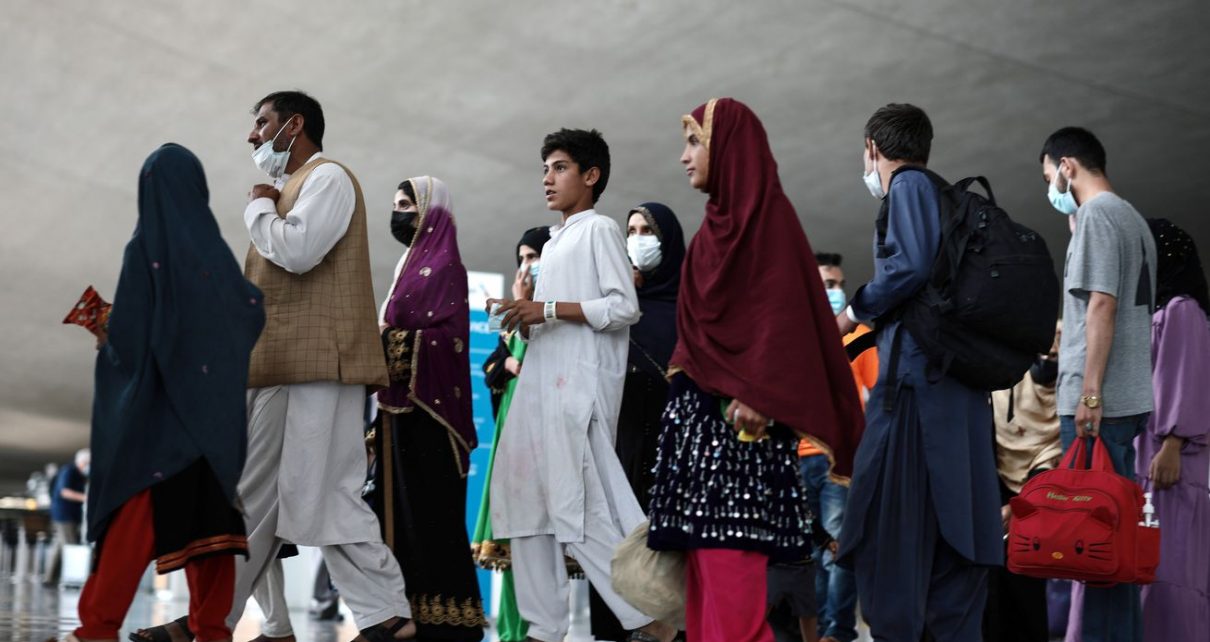
Afghan arrivals and Trump-era policies pose obstacles to resettling 125,000 refugees this year.
After the US refugee program hit historic lows during Donald Trump’s administration, President Joe Biden attempted to revive the program by raising the annual cap on admissions to 125,000.
Despite these efforts, the US is still not taking in more refugees.
Tens of thousands of Afghans have arrived in the US since the American withdrawal from Afghanistan in August. The urgent need — and the lasting damage done by the Trump administration — has overtaxed a refugee program that has slowed to a crawl in recent months.
In fiscal year 2021, which ended in September, the US resettled the lowest number of refugees in the history of its refugee program. Recently, the State Department reported the US resettled just 401 refugees in October, down from 3,774 the month before, one month after Biden’s new cap went into effect. A State Department spokesperson told Vox that the agency had temporarily halted refugee admissions as of October 29 through January 11, 2022, with some exceptions.
At the current pace, the US won’t come within striking distance of the 125,000 cap by the end of the fiscal year — and, given the State Department’s new refugee guidance, it’s unlikely that refugee agencies will be able to expand capacity to ramp up that pace soon.
There are legitimate reasons why the recent resettlement numbers are so low. The US government and refugee agencies have been primarily focused on resettling Afghans who fled their home country amid the US withdrawal. And the entire refugee apparatus — from the federal officials who assess refugee claims to the agencies that help with resettlement — shrank significantly during the Trump administration due to severe funding cuts.
About 70,000 Afghans have been admitted to the US on “parole,” a temporary form of humanitarian relief that allows them to apply for work permits and shields them from deportation for a period of two years. Though technically refugees, these Afghan parolees don’t count towards the refugee cap. They still have many of the same needs as refugees — including financial assistance, job placement, and temporary housing — and refugee agencies have had to step in to provide for them.
The State Department spokesperson said that the agency was temporarily prioritizing resettling Afghans — in addition to refugees who have already made travel arrangements, who are seeking to reunite with family, and who have otherwise urgent cases — in an effort to ensure that refugee agencies have the capacity to provide those services.
It has fallen to refugee agencies to facilitate the resettlement process. That has consumed refugee agencies still in the process of rebuilding after being was gutted by the Trump administration, which set a cap of 15,000 refugee admissions in 2020, a record low. Both the international and domestic infrastructure has suffered as a result, with refugee agencies forced to close many of their offices amid funding cuts, and fewer refugees being interviewed and vetted by federal officials abroad.
But with the right support from the federal government, refugee agencies might be able to increase their capacity, and eventually help resettle the highest number of refugees in a single year since 1993. Facilitating that would help the US make up for the past few years in which it abdicated its role as a global leader on refugees. Given that there is no guarantee that the next administration will prioritize the US refugee program in the same way, the Biden administration can’t afford to squander that chance.
The federal government has had trouble setting refugee agencies up for success
The Biden administration has made efforts to ease the burden on refugee agencies by streamlining the resettlement of Afghan parolees. It has waived costly application fees for work permits and green cards that can total over $10,000 per family. It has also piloted a program allowing private individuals and organizations to apply to sponsor Afghans, covering their resettlement costs and helping them secure housing, basic necessities, legal and medical services for at least 90 days.
And Congress has allocated $6.3 billion to help resettle a projected 95,000 Afghans through 2022, giving them access to much-needed social services (a sweeping measure that still falls short of advocates’ calls to provide Afghan parolees with an expedited path to permanent residence.)
Refugee agencies are nevertheless torn between competing obligations to Afghan parolees and other refugees.
“It’s been such an unusual process with the Afghans and a lot of new adjustments. We’re, of course, very eager to welcome them,” Matthew Soerens, US Director of Church Mobilization for the refugee resettlement agency World Relief, said. “We are also, of course, concerned about Congolese refugees who’ve been in camps for literally a generation or more, who want to be reunited with families, who had hoped that would be possible under the new administration and who might be waiting longer than they had anticipated. So it’s a difficult issue.”
Looking back, Soerens said that refugee agencies might have been better prepared to manage the influx of Afghans if the federal government had acted sooner to coordinate an evacuation of Afghan allies and at-risk Afghans prior to the US withdrawal. But the fall of the Afghan government happened more quickly than the Biden administration anticipated, and more than 124,000 people were airlifted out of the country over the course of two chaotic weeks in August, leaving refugee agencies in a lurch.
“We’re doing the very best we can but it’s a stress on our capacity, for sure,” Soerens said. “I don’t want to sound ungrateful because we’ve been critical for years of the very low numbers. But it would be nice if this could have been coordinated in a more orderly fashion.”
Refugee agencies are struggling to ramp up workloads
Refugee agencies are under immense pressure to resettle Afghans while rapidly rebuilding in the wake of the Trump era.
Since agencies’ federal funding is tied to the refugee cap, many saw their budgets decrease significantly under Trump, forcing them to dramatically scale back their operations. Soerens said that World Relief closed eight of its offices over the past five years, some of which had been operating since the 1970s. That involved laying off personnel, many of whom had decades in institutional knowledge.
Amassing that expertise and capacity again will not happen overnight, nor will reestablishing relationships with landlords and employers agencies once relied upon to provide refugees with housing and work. But agencies are working quickly to meet the sudden crush of demand. Krish O’Mara Vignarajah, the president and CEO of Lutheran Immigration and Refugee Service, said that her agency has been able to bring 10 new sites online in recent months, with several more in the works, and has nearly doubled the workforce at its national headquarters since last year.
Aside from those challenges stateside, refugee agencies depend on the federal government to interview and process refugees abroad, ensuring that there is a pipeline of refugees ready to be resettled. Once referred to US authorities by the United Nations, refugees are pre-screened at one of the State Department’s Refugee Support Centers abroad. Then, US Citizenship and Immigration Services conducts in-person interviews with refugee applicants to ensure that they are eligible for refugee status.
But those interviews aren’t occurring at the pace necessary to ensure that the US can meet its resettlement goals. The number of refugee applicants interviewed annually dropped from 125,000 to just 44,000 between fiscal years 2016 and 2019, O’Mara Vignarajah said.
“This is the government’s responsibility,” she said. “We need to increase the efficiency of vetting and application processing, without comprising stringent security integrity standards.”
That requires staffing up in the USCIS refugee corps, which decreased in size by roughly a third between 2017 and 2020. But it also involves getting rid of overly repetitive or burdensome aspects of refugee processing. There are, for example, multiple and likely duplicative biographical and biometric checks for refugee applicants conducted by different US government agencies that could be consolidated, O’Mara Vignarajah said.
“Every administration has added layers and hurdles to clear. Meanwhile, nothing is ever taken away as overly repetitive or burdensome,” she said. “I think that there is an opportunity to improve the system.”
Refugees and refugee agencies need more assurance from the federal government
To meet Biden’s refugee cap, immigration officials and refugee agency staff need stability.
Refugee agencies have had to gauge what future demand for their services might be as part of their calculations of how much to scale up. They need assurance that they won’t have to close the same offices they’re reopening now in a few years. And their employees want job security — without it, it’s difficult to hire (or rehire) top talent.
The White House currently sets the annual refugee admissions cap, with no congressionally mandated ceiling or floor. But the Guaranteed Refugee Ceiling Enhancement Act, or GRACE Act — reintroduced in March by Sen. Ed Markey (D-MA) and Reps. Zoe Lofgren (D-CA) and Joe Neguse (D-CA) — would set a floor of 125,000 in line with Biden’s current cap, giving refugee agencies a more permanent commitment from the federal government and allowing them to plan without inhibition.
“The way the refugee program is set up with a lot of authority given to the executive branch has proven in the last few years to be very unstable for refugee resettlement organizations,” Soerens said. “The more confidence we can have in what the future of the program is going to look like, the more we can expand with confidence.”




